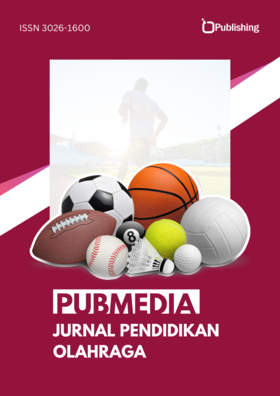The Role of Sports Medicine in Preventing and Managing Common Injuries in Athletes
DOI:
https://doi.org/10.47134/jpo.v1i3.378Keywords:
Medicine Sport, Injured Athletes, SPSS Program, EmergencyAbstract
Many international athletic organizations have proposed injury-reduction strategies. These practices include injury screening, emergency medical care, along with injury management measures prior to return-to-play. The extent to which these methods are being adopted in a developing nation like Iraq is uncertain. This paper was contributed to study the role of sports medicine in preventing and managing common injuries in athletes. Our paper focused on the role of sports medicine in treating injured athletes in Iraq. To build up, our methodology’s study was enrolled rate of acute injuries for 80 cases based on organized the demographic characteristics of sports players with three basics which are football, athletics, and handball. The data were analysed using the SPSS program. This study was presented a cumulative analysed and covered all 80 cases during period from 17th January 2022 to 19th March 2023.mThe findings demonstrated a lack of pre-season screening and return-to-play preparedness for all injured athletes. Furthermore, for the majority of injury categories, best practice standards were not followed. This study identified constraints, including sports resource providers' inadequate knowledge, insufficient and insufficiently specialized facilities for treating injured athletes, and policies mandating treatment for injured athletes. These obstacles hinder the implementation of best medical practices.
References
Alonso, J. M., Jacobsson, J., Timpka, T., et al. (2015). Preparticipation injury complaint is a risk factor for injury: a prospective study of the Moscow 2013 IAAF Championships. British Journal of Sports Medicine, 49, 1118–1124. DOI: https://doi.org/10.1136/bjsports-2014-094359
Annear, A., Sole, G., & Devan, H. (2019). What are the current practices of sports physiotherapists in integrating psychological strategies during athletes' return-to-play rehabilitation? Mixed methods systematic review. Physical Therapy in Sport, 38, 96–105. DOI: https://doi.org/10.1016/j.ptsp.2019.04.018
Bleakley, C., Tully, M., & O'Connor, S. (2011). Epidemiology of adolescent rugby injuries: a systematic review. Journal of Athletic Training, 46(5), 555–565. DOI: https://doi.org/10.4085/1062-6050-46.5.555
Bouchard, M., & Dexter, W. (2005). Sideline Care of Abrasions and Lacerations. The Physician and Sports Medicine, 33(2), 21–29. DOI: https://doi.org/10.3810/psm.2005.02.47
Brooks, M. A., Peterson, K., Biese, K., Sanfilippo, J., Heiderscheit, B. C., & Bell, D. R. (2016). Concussion Increases Odds of Sustaining a Lower Extremity Musculoskeletal Injury After Return to Play Among Collegiate Athletes. The American Journal of Sports Medicine, 44(3), 742–747. DOI: https://doi.org/10.1177/0363546515622387
Casa, D. J., Guskiewicz, K. M., Anderson, S. A., Courson, R. W., Heck, J. F., Jimenez, C. C., et al. (2012). National athletic trainers' association position statement: preventing sudden death in sports. Journal of Athletic Training, 47(1), 96–118. DOI: https://doi.org/10.4085/1062-6050-47.1.96
D'Souza, D. (1994). Track and Field athlete's injury record for one year. British Journal of Sports Medicine, 2(3), 197–202. DOI: https://doi.org/10.1136/bjsm.28.3.197
Drew, M., & Finch, C. (2016). The Relationship Between Training Load and Injury, Illness and Soreness: A Systematic and Literature Review. Sports Medicine, 46(6), 861–883. DOI: https://doi.org/10.1007/s40279-015-0459-8
Emery, C. A., & Pasanen, K. (n.d.). Current trends in sport injury prevention. Best Practice & Research Clinical Rheumatology.
McCrory, P., Meeuwisse, W., Dvorak, J., et al. (2017). Consensus statement on concussion in sport—the 5th international conference on concussion in sport held in Berlin, October 2016. British Journal of Sports Medicine, 51, 838–847.
Mayer, F., Bonaventura, K., Cassel, M., Mueller, S., Weber, J., Scharhag-Rosenberger, F., et al. (2012). Medical results of preparticipation examination in adolescent athletes. British Journal of Sports Medicine, 46(7), 524–530. DOI: https://doi.org/10.1136/bjsports-2011-090966
FIFA. (2013). Player's health. Retrieved September 9, 2013, from https://www.fifa.com/about-fifa/who-we-are/news/players-health-584908
Freitag, A., Kirkwood, G., & Pollock, A. (2015). Rugby injury surveillance and prevention programmes: are they effective? BMJ: British Medical Journal, 350(8005), h1587–h1583. DOI: https://doi.org/10.1136/bmj.h1587
Fuller, C. W., & Walker, J. (2006). Quantifying the functional rehabilitation of injured football players. British Journal of Sports Medicine, 40(2), 151–157. doi: 10.1136/bjsm.2005.021048. DOI: https://doi.org/10.1136/bjsm.2005.021048
Gabbett, T. J. (2016). The training-injury prevention paradox: should athletes be training smarter and harder? British Journal of Sports Medicine, 50(5), 273–280. DOI: https://doi.org/10.1136/bjsports-2015-095788
Gouttebarge, V., Kerkhoffs, G., & Lambert, M. (2016). Prevalence and determinants of symptoms of common mental disorders in retired professional Rugby Union players. European Journal of Sport Science, 16(5), 568–v. DOI: https://doi.org/10.1080/17461391.2015.1086819
Hägglund, M., Waldén, M., & Ekstrand, J. (2009). UEFA injury study--an injury audit of European Championships 2006 to 2008. British Journal Of Sports Medicine, 43(7), 483–489. DOI: https://doi.org/10.1136/bjsm.2008.056937
Hassanmirzae, B., Haratian, Z., Moghadam, N., & Ashraf-Ganjouei, A. (2017). Baseline Properties of the Sport Concussion Assessment Tool 3 (SCAT3) in Iranian Professional League Football Players. Asian Journal of Sports Medicine, 8(4), 1–5. DOI: https://doi.org/10.5812/asjsm.58076
Heyworth, B. E., Novais, E. N., Murray, K., Cvetanovich, G., Zurakowski, D., Millis, M. B., et al. (2016). Return to Play After Periacetabular Osteotomy for Treatment of Acetabular Dysplasia in Adolescent and Young Adult Athletes. The American Journal of Sports Medicine, 44(6), 1573–1581. DOI: https://doi.org/10.1177/0363546516632743
Hodge, D. K., & Safran, M. R. (2002). Sideline management of common dislocations. Curr Sports Med Rep, 1, 149. DOI: https://doi.org/10.1249/00149619-200206000-00005
IAAF. (2013). Medical manual. Retrieved from https://www.iaaf.org/about-iaaf/documents.
IOC Medical Commission. (2013). Retrieved from https://www.olympic.org/medical-and-scientific-commission.
Liu, H., Garrett, W. E., Moorman, C. T., & Yu, B. (2012). Injury rate, mechanism, and risk factors of hamstring strain injuries in sports: a review of the literature. J Sport Health Sci, 1, 92–101. DOI: https://doi.org/10.1016/j.jshs.2012.07.003
Lubega, S. K., Lambert, M., Makubuya, T., Babul, S., Muwonge, H., Zavuga, R., et al. (2019). Management and Prevention of Sport- Related Concussions in Uganda: A Case Study. American Journal of Sports Sciences and Medicine, 7(2), 34–39. DOI: https://doi.org/10.12691/ajssm-7-2-2
Makubuya, T., Lubega, S. K., & Kalibbala, L. S. (2020). Pre-participation Evaluations and the Relative risk of Injuries in Ugandan Sports. Medicine & Science in Sports & Exercise, 52(7S), 423–424. DOI: https://doi.org/10.1249/01.mss.0000678472.89037.a7
Downloads
Published
How to Cite
Issue
Section
License
Copyright (c) 2024 Karrar Yaareb Kattoof

This work is licensed under a Creative Commons Attribution 4.0 International License.










